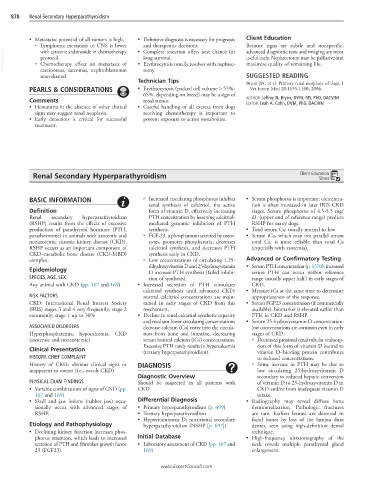Page 1746 - Cote clinical veterinary advisor dogs and cats 4th
P. 1746
878 Renal Secondary Hyperparathyroidism
• Metastatic potential of all tumors is high. • Definitive diagnosis is necessary for prognosis Client Education
○ Lymphoma metastasis to CNS is lower • Complete resection offers best chance for Because signs are subtle and nonspecific,
and therapeutic decisions.
VetBooks.ir ○ Chemotherapy effect on metastasis of • Erythrocytosis usually resolves with nephrec- useful early. Nephrectomy may be palliative and
with cytosine arabinoside in chemotherapy
advanced diagnostic tests and imaging are most
long survival.
protocol.
maximize quality of remaining life.
carcinomas, sarcomas, nephroblastomas
unevaluated tomy. SUGGESTED READING
Technician Tips Bryan JN, et al: Primary renal neoplasia of dogs. J
PEARLS & CONSIDERATIONS • Erythrocytosis (packed cell volume > 55%- Vet Intern Med 20:1155-1160, 2006.
65%, depending on breed) may be a sign of
Comments renal tumor. AUTHOR: Jeffrey N. Bryan, DVM, MS, PhD, DACVIM
• Hematuria in the absence of other clinical • Careful handling of all excreta from dogs EDITOR: Leah A. Cohn, DVM, PhD, DACVIM
signs may suggest renal neoplasia. receiving chemotherapy is important to
• Early detection is critical for successful prevent exposure to active metabolites.
treatment.
Renal Secondary Hyperparathyroidism Client Education
Sheet
BASIC INFORMATION ○ Increased circulating phosphorus inhibits • Serum phosphorus is important: concentra-
renal synthesis of calcitriol, the active tion is often increased in later IRIS CKD
Definition form of vitamin D, effectively increasing stages. Serum phosphorus of 4.5-5.5 mg/
Renal secondary hyperparathyroidism PTH concentration by lessening calcitriol- dL (upper end of reference range) predicts
(RSHP) results from the effects of excessive mediated genomic inhibition of PTH RSHP for many dogs.
production of parathyroid hormone (PTH, synthesis. • Total serum Ca: usually normal to low
parathormone) in animals with azotemic and ○ FGF-23, a phosphatonin secreted by osteo- • Serum iCa, which may not parallel serum
nonazotemic chronic kidney disease (CKD). cytes, promotes phosphaturia, decreases total Ca, is more reliable than total Ca
RSHP occurs as an important component of calcitriol synthesis, and decreases PTH (especially with azotemia).
CKD–metabolic bone disease (CKD-MBD) synthesis early in CKD.
complex. ○ Low concentrations of circulating 1,25- Advanced or Confirmatory Testing
dihydroxyvitamin D and 25-hydroxyvitamin • Serum PTH concentration (p. 1370): increased
Epidemiology D increase PTH synthesis (failed inhibi- serum PTH can occur within reference
SPECIES, AGE, SEX tion of synthesis). range (usually upper half) in early stages of
Any animal with CKD (pp. 167 and 169) • Increased secretion of PTH stimulates CKD.
calcitriol synthesis until advanced CKD; • Measure iCa at the same time to determine
RISK FACTORS normal calcitriol concentrations are main- appropriateness of the response.
CKD: International Renal Interest Society tained in early stages of CKD from this • Serum FGF23 concentration (if commercially
(IRIS) stages 3 and 4 very frequently; stage 2 mechanism. available): biomarker is elevated earlier than
commonly; stage 1 up to 30% • Decline in renal calcitriol synthetic capacity PTH in CKD and RSHP.
and resultant lower circulating concentrations • Serum 25-hydroxyvitamin D concentration:
ASSOCIATED DISORDERS decrease calcium (Ca) entry into the circula- low concentrations are common even in early
Hyperphosphatemia, hypocalcemia, CKD tion from bone and intestine, decreasing stages of CKD.
(azotemic and nonazotemic) serum ionized calcium (iCa) concentrations. ○ Decreased proximal renal tubular reabsorp-
Excessive PTH rarely results in hypercalcemia tion of this form of vitamin D bound to
Clinical Presentation (tertiary hyperparathyroidism). vitamin D–binding protein contributes
HISTORY, CHIEF COMPLAINT to reduced concentrations.
History of CKD; obvious clinical signs or DIAGNOSIS ○ Some increase in PTH may be due to
inapparent to owner (i.e., occult CKD) low circulating 25-hydroxyvitamin D
Diagnostic Overview secondary to reduced hepatic conversion
PHYSICAL EXAM FINDINGS Should be suspected in all patients with of vitamin D to 25-hydroxyvitamin D in
• Variable combinations of signs of CKD (pp. CKD CKD and/or from inadequate vitamin D
167 and 169) intake.
• Skull and jaw lesions (rubber jaw) occa- Differential Diagnosis • Radiography may reveal diffuse bone
sionally occur with advanced stages of • Primary hyperparathyroidism (p. 499) demineralization. Pathologic fractures
RSHP. • Tertiary hyperparathyroidism are rare. Earliest lesions are detected in
• Hypovitaminosis D; nutritional secondary facial bones by loss of the lamina dura
Etiology and Pathophysiology hyperparathyroidism (NSHP [p. 697]) dentes, seen using high-definition dental
• Declining kidney function increases phos- technique.
phorus retention, which leads to increased Initial Database • High-frequency ultrasonography of the
secretion of PTH and fibroblast growth factor • Laboratory assessment of CKD (pp. 167 and neck reveals multiple parathyroid gland
23 (FGF23). 169) enlargement.
www.ExpertConsult.com

